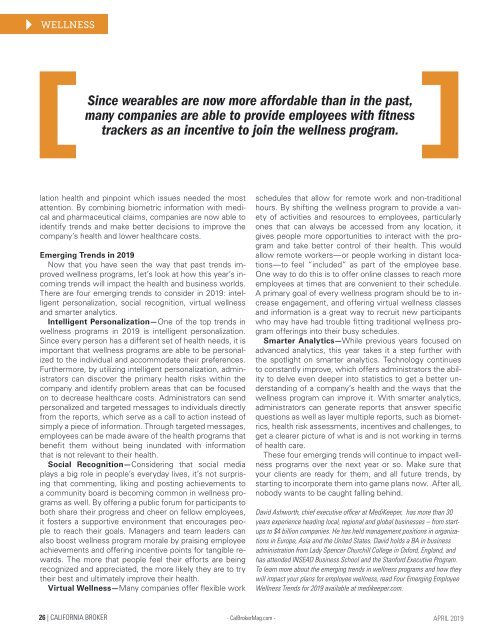California Broker April 2019
Create successful ePaper yourself
Turn your PDF publications into a flip-book with our unique Google optimized e-Paper software.
LIFE WELLNESS INSURANCE<br />
Since wearables are now more affordable than in the past,<br />
many companies are able to provide employees with fitness<br />
trackers as an incentive to join the wellness program.<br />
lation health and pinpoint which issues needed the most<br />
attention. By combining biometric information with medical<br />
and pharmaceutical claims, companies are now able to<br />
identify trends and make better decisions to improve the<br />
company’s health and lower healthcare costs.<br />
Emerging Trends in <strong>2019</strong><br />
Now that you have seen the way that past trends improved<br />
wellness programs, let’s look at how this year’s incoming<br />
trends will impact the health and business worlds.<br />
There are four emerging trends to consider in <strong>2019</strong>: intelligent<br />
personalization, social recognition, virtual wellness<br />
and smarter analytics.<br />
Intelligent Personalization—One of the top trends in<br />
wellness programs in <strong>2019</strong> is intelligent personalization.<br />
Since every person has a different set of health needs, it is<br />
important that wellness programs are able to be personalized<br />
to the individual and accommodate their preferences.<br />
Furthermore, by utilizing intelligent personalization, administrators<br />
can discover the primary health risks within the<br />
company and identify problem areas that can be focused<br />
on to decrease healthcare costs. Administrators can send<br />
personalized and targeted messages to individuals directly<br />
from the reports, which serve as a call to action instead of<br />
simply a piece of information. Through targeted messages,<br />
employees can be made aware of the health programs that<br />
benefit them without being inundated with information<br />
that is not relevant to their health.<br />
Social Recognition—Considering that social media<br />
plays a big role in people’s everyday lives, it’s not surprising<br />
that commenting, liking and posting achievements to<br />
a community board is becoming common in wellness programs<br />
as well. By offering a public forum for participants to<br />
both share their progress and cheer on fellow employees,<br />
it fosters a supportive environment that encourages people<br />
to reach their goals. Managers and team leaders can<br />
also boost wellness program morale by praising employee<br />
achievements and offering incentive points for tangible rewards.<br />
The more that people feel their efforts are being<br />
recognized and appreciated, the more likely they are to try<br />
their best and ultimately improve their health.<br />
Virtual Wellness—Many companies offer flexible work<br />
schedules that allow for remote work and non-traditional<br />
hours. By shifting the wellness program to provide a variety<br />
of activities and resources to employees, particularly<br />
ones that can always be accessed from any location, it<br />
gives people more opportunities to interact with the program<br />
and take better control of their health. This would<br />
allow remote workers—or people working in distant locations—to<br />
feel “included” as part of the employee base.<br />
One way to do this is to offer online classes to reach more<br />
employees at times that are convenient to their schedule.<br />
A primary goal of every wellness program should be to increase<br />
engagement, and offering virtual wellness classes<br />
and information is a great way to recruit new participants<br />
who may have had trouble fitting traditional wellness program<br />
offerings into their busy schedules.<br />
Smarter Analytics—While previous years focused on<br />
advanced analytics, this year takes it a step further with<br />
the spotlight on smarter analytics. Technology continues<br />
to constantly improve, which offers administrators the ability<br />
to delve even deeper into statistics to get a better understanding<br />
of a company’s health and the ways that the<br />
wellness program can improve it. With smarter analytics,<br />
administrators can generate reports that answer specific<br />
questions as well as layer multiple reports, such as biometrics,<br />
health risk assessments, incentives and challenges, to<br />
get a clearer picture of what is and is not working in terms<br />
of health care.<br />
These four emerging trends will continue to impact wellness<br />
programs over the next year or so. Make sure that<br />
your clients are ready for them, and all future trends, by<br />
starting to incorporate them into game plans now. After all,<br />
nobody wants to be caught falling behind.<br />
David Ashworth, chief executive officer at MediKeeper, has more than 30<br />
years experience heading local, regional and global businesses – from startups<br />
to $4 billion companies. He has held management positions in organizations<br />
in Europe, Asia and the United States. David holds a BA in business<br />
administration from Lady Spencer Churchill College in Oxford, England, and<br />
has attended INSEAD Business School and the Stanford Executive Program.<br />
To learn more about the emerging trends in wellness programs and how they<br />
will impact your plans for employee wellness, read Four Emerging Employee<br />
Wellness Trends for <strong>2019</strong> available at medikeeper.com.<br />
26 | CALIFORNIA BROKER - Cal<strong>Broker</strong>Mag.com -<br />
APRIL <strong>2019</strong>

















